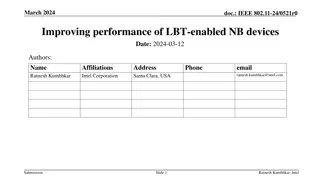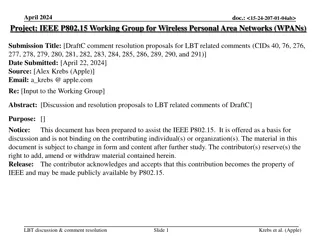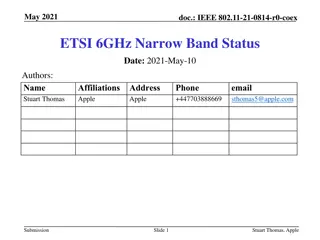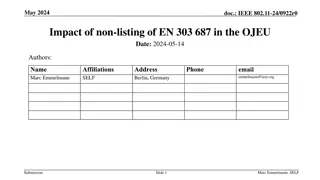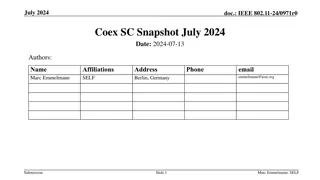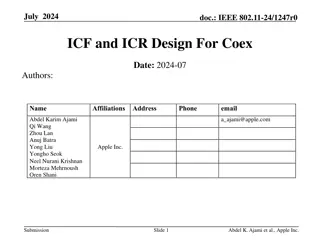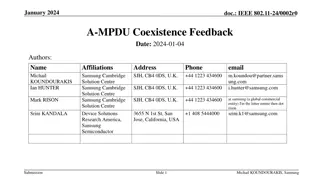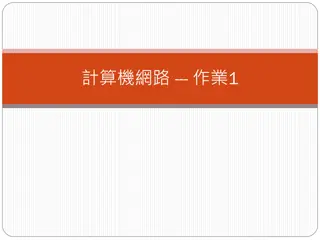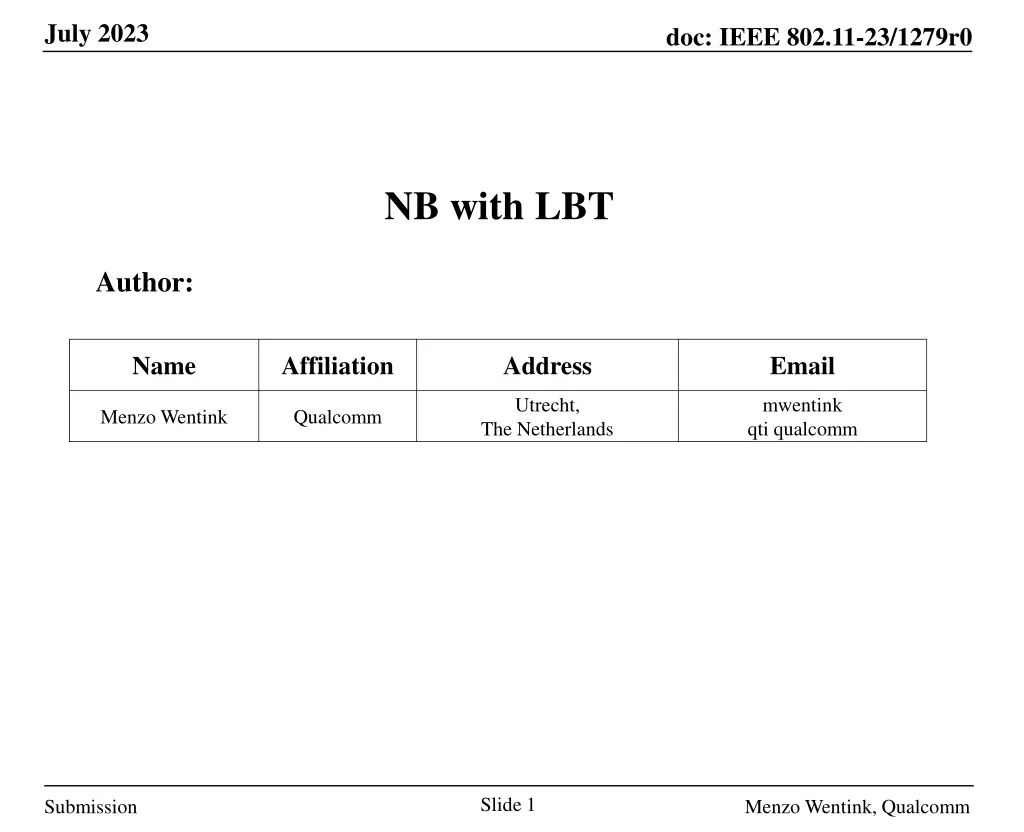
Exploring NB with LBT for Wi-Fi Enhancements
Dive into how NB with LBT technology can enhance Wi-Fi performance through different configurations and experiments, showcasing scenarios and simulation parameters for better understanding and implementation.
Download Presentation

Please find below an Image/Link to download the presentation.
The content on the website is provided AS IS for your information and personal use only. It may not be sold, licensed, or shared on other websites without obtaining consent from the author. If you encounter any issues during the download, it is possible that the publisher has removed the file from their server.
You are allowed to download the files provided on this website for personal or commercial use, subject to the condition that they are used lawfully. All files are the property of their respective owners.
The content on the website is provided AS IS for your information and personal use only. It may not be sold, licensed, or shared on other websites without obtaining consent from the author.
E N D
Presentation Transcript
July 2023 doc: IEEE 802.11-23/1279r0 NB with LBT Author: Name Affiliation Address Email Utrecht, mwentink qti qualcomm Menzo Wentink Qualcomm The Netherlands Slide 1 Submission Menzo Wentink, Qualcomm
July 2023 doc: IEEE 802.11-23/1279r0 Introduction These slides cover some scenarios that may illustrate how NB with LBT can be beneficial for NB and Wi-Fi Three configurations are considered Wi-Fi / NBFH NBFH / NBFH NB-UWB / NBFH Slide 2 Submission Menzo Wentink, Qualcomm
July 2023 doc: IEEE 802.11-23/1279r0 Wi-Fi / NBFH experiments Slide 3 Submission Menzo Wentink, Qualcomm
July 2023 doc: IEEE 802.11-23/1279r0 Wi-Fi / NBFH experiments These experiments show duty cycled Wi-Fi traffic in the presence of several NBFH links Wi-Fi has the following duty cycle 0.5 s on, 2 s off There are also some improvements to the eDAA scanning algorithm relative to prior submissions two sweeps over the entire 500 MHz per CCA evaluation (instead of one sweep per CCA evaluation as per prior simulation results) two sweeps per 0.5 s is actually quite high, in practice this may imply scanning just over certain center frequencies, which may impose problems when OFDMA is used by Wi-Fi Slide 4 Submission Menzo Wentink, Qualcomm
July 2023 doc: IEEE 802.11-23/1279r0 Wi-Fi / NBFH simulation parameters Wi-Fi settings Tx power: 23 dBm at AP (LPI), 21 dBm at STA (LPI) packet size: 2 ms downlink traffic, full buffer channel width: 160 MHz max bitrate: 2402 Mbps at HE MCS 11, 160 MHz, 2x996-tone RU, Nss = 2, 800 ns GI frame exchange: RTS/CTS/A-MPDU/BA start time: 5 s NBFH settings Tx power: 14 dBm (VLP) dwell time: 625 us hop width: 4 MHz (30 Mbps max PHY rate, Nss = 1) hopping pattern: random, 125 hops (500 MHz total) eDAA settings: 0.5 s between CCAs CCA trigger settings: 7 us CCA before each hop, FBE, trigger threshold 3, 20 MHz segments start time at ~0.5 s intervals starting at 0 s downlink traffic, full buffer Channel model AWGN channel with a breakpoint at 5 m pathloss = 40.05 + 20log10(f/2.4) + 20log10(min(d, b)) + (d > b) * (35log10(d/b)) where f = 5.18 GHz, d = distance, b = breakpoint = 5 m Slide 5 Submission Menzo Wentink, Qualcomm
July 2023 doc: IEEE 802.11-23/1279r0 Wi-Fi / NBFH topology AP LPI Wi-Fi link downlink traffic VLP NBFH links VLP NBFH links STA nb_r1252_dc_3u3d_r4a_r1 Slide 6 Submission Menzo Wentink, Qualcomm
July 2023 doc: IEEE 802.11-23/1279r0 Wi-Fi-only (no NBFH) (this plot is not defined for this experiment) nb_r1252_dc_3u3d_r4a_r1 Slide 7 Submission Menzo Wentink, Qualcomm
July 2023 doc: IEEE 802.11-23/1279r0 Wi-Fi / NBFH (eDAA) nb_r1252_dc_3u3d_r4b_r1 Slide 8 Submission Menzo Wentink, Qualcomm
July 2023 doc: IEEE 802.11-23/1279r0 Wi-Fi / NBFH (LBT with CCA trigger) nb_r1252_dc_3u3d_r4c_r1 Slide 9 Submission Menzo Wentink, Qualcomm
July 2023 doc: IEEE 802.11-23/1279r0 Observations (Wi-Fi / NBFH) eDAA appears to be inadequate as a coexistence mechanism the response time is too long no protection of ongoing NB transmissions LBT with CCA trigger works quite well quick response to other traffic quick reuse of the channel when other traffic is no longer present low latency and stable throughput, both for Wi-Fi and NB Slide 10 Submission Menzo Wentink, Qualcomm
July 2023 doc: IEEE 802.11-23/1279r0 NBFH / NBFH experiments Slide 11 Submission Menzo Wentink, Qualcomm
July 2023 doc: IEEE 802.11-23/1279r0 NBFH / NBFH experiments The following experiments show results for 7 NBFH links in relative close proximity, with more pathloss on each of the links relative to the prior experiments the higher pathloss causes that colliding hops will not be received at any of the receivers Slide 12 Submission Menzo Wentink, Qualcomm
July 2023 doc: IEEE 802.11-23/1279r0 NBFH simulation parameters NBFH settings Tx power: 14 dBm (VLP) dwell time: 625 us hop width: 4 MHz (30 Mbps max PHY rate, Nss = 1) hopping pattern: random, 125 hops (500 MHz total) eDAA settings: 0.5 s between CCAs, 60% occupancy threshold, 20 MHz segments CCA trigger settings: 7 us CCA before each hop, trigger threshold 3, 20 MHz segments start time at ~0.5 s intervals starting at 0 s downlink traffic, full buffer Channel model AWGN channel with a breakpoint at 5 m pathloss = 40.05 + 20log10(f/2.4) + 20log10(min(d, b)) + (d > b) * (35log10(d/b)) where f = 5.18 GHz, d = distance, b = breakpoint = 5 m Slide 13 Submission Menzo Wentink, Qualcomm
July 2023 doc: IEEE 802.11-23/1279r0 NBFH / NBFH topology 7 NBFH links nb_r1501_nbnb_3u3d_r1 Slide 14 Submission Menzo Wentink, Qualcomm
July 2023 doc: IEEE 802.11-23/1279r0 NBFH / NBFH (eDAA) (500 MHz hopping BW) nb_1501_nbnb_edaa_r1 Slide 15 Submission Menzo Wentink, Qualcomm
July 2023 doc: IEEE 802.11-23/1279r0 NBFH / NBFH (LBT with CCA trigger) (500 MHz hopping BW) nb_r1501_nbnb_3u3d_r1 Slide 16 Submission Menzo Wentink, Qualcomm
July 2023 doc: IEEE 802.11-23/1279r0 NBFH / NBFH (eDAA) (300 MHz hopping BW) nb_1501_nbnb_edaa_r2 Slide 17 Submission Menzo Wentink, Qualcomm
July 2023 doc: IEEE 802.11-23/1279r0 NBFH / NBFH (LBT with CCA trigger) (300 MHz hopping BW) nb_r1501_nbnb_3u3d_r2 Slide 18 Submission Menzo Wentink, Qualcomm
July 2023 doc: IEEE 802.11-23/1279r0 Observations (NBFH / NBFH) NBFH can benefit from using LBT interference to ongoing NB transmissions is avoided Slide 19 Submission Menzo Wentink, Qualcomm
July 2023 doc: IEEE 802.11-23/1279r0 NB-UWB / NBFH experiments Slide 20 Submission Menzo Wentink, Qualcomm
July 2023 doc: IEEE 802.11-23/1279r0 NB-UWB introduction Narrowband assisted ultrawideband (NB-UWB) has been proposed in 802.15.4ab as a mechanism to boost link budget for UWB UWB packets are transmitted as multiple shorter fragments, each using a lower duty cycle in the 1 ms measurement interval, which allows for higher transmit power fragments can be combined at the receiver The NB protocol exchange is used to synchronize the UWB transmissions and to exchange measurement data Poll / Response / Responser report / Initiator report An exemplary NB-UWB frame exchange is shown below NB NB NB NB NB poll NB UWB 1 UWB 2 UWB 3 UWB 4 UWB 5 UWB 6 UWB 7 UWB 8 responder report 1 responder report 2 initiator report 1 initiator report 2 response slot time (us) 1000 1000 1000 1000 1000 1000 1000 1000 1000 1000 1000 1000 1000 1000 Tx time (us) 500 500 0 0 0 0 0 0 0 0 990 990 990 990 Slide 21 Submission Menzo Wentink, Qualcomm
July 2023 doc: IEEE 802.11-23/1279r0 NB-UWB settings The following NB-UWB settings were used in the simulations slot time: 1 ms ranging round: 2 initial NB slots + 8 UWB slots + 4 NB report slots = 14 ms ranging block: 6 rounds = 84 ms continuously repeated blocks (continuous ranging session) duty cycle for 1 responder: 3% per node NB bandwidth: 2.5 MHz NB Tx power: 14 dBm The simulated scenario is UNII-3 where 80 MHz is assumed to be occupied by Wi-Fi and 40 MHz is shared by NBFH and NB-UWB Slide 22 Submission Menzo Wentink, Qualcomm
July 2023 doc: IEEE 802.11-23/1279r0 NB-UWB / NBFH simulation parameters NB-UWB settings Tx power: 14 dBm slot time: 1000 us channel width: 2.5 MHz PSD: 10 dBm/MHz fixed NB channel Tx duty cycle: 3% per node (6% total) start time: 0 s 11.9 ranging rounds per second target NBFH settings Tx power: 14 dBm dwell time: 625 us hop width: 1 MHz PSD: 14 dBm/MHz 40 hops in 40 MHz, random hopping pattern start time: 5 s Channel model AWGN channel with a breakpoint at 5 m pathloss = 40.05 + 20log10(f/2.4) + 20log10(min(d, b)) + (d > b) * (35log10(d/b)) where f = 5.18 GHz, d = distance, b = breakpoint = 5 m Slide 23 Submission Menzo Wentink, Qualcomm
July 2023 doc: IEEE 802.11-23/1279r0 NB-UWB / NBFH coexistence setup NBFH NB-UWB Slide 24 Submission Menzo Wentink, Qualcomm
July 2023 doc: IEEE 802.11-23/1279r0 NB-UWB / NBFH (scheduled NB-UWB, no LBT) NBFH starts here 30% less rounds 20% more Tx time per round NB-UWB metrics when NBFH is active: ~8 rounds/s (30% less rounds) 3.0 ms Tx time per node per round (20% more Tx time per round) nau_r1708_r2a Slide 25 Submission Menzo Wentink, Qualcomm
July 2023 doc: IEEE 802.11-23/1279r0 NB-UWB / NBFH (scheduled NB-UWB, LBT) NBFH link starts here 6% less rounds 0.4% more Tx time per round NB-UWB metrics when NBFH is active: ~10.2 rounds/s (6 % less rounds) 2.51 ms Tx time per node per round (0.4% more Tx time per round) nau_r1708_r2b Slide 26 Submission Menzo Wentink, Qualcomm
July 2023 doc: IEEE 802.11-23/1279r0 Observations (NB-UWB / Wi-Fi) The NB-UWB protocol has little resilience against frame loss several protocol frames have no acknowledgement there are no retries frame loss can be caused by collisions with hops of a nearby NBFH link LBT helps protect the NB-UWB protocol frames the number of successful ranging rounds is increased when LBT is used LBT also reduces power consumption at the NB-UWB device NB-UWB transmissions are suppressed when high interference might cause them to fail anyway, reducing unnecessary transmit time Slide 27 Submission Menzo Wentink, Qualcomm
July 2023 doc: IEEE 802.11-23/1279r0 Appendix Overview of NB channel access mechanisms Slide 28 Submission Menzo Wentink, Qualcomm
July 2023 doc: IEEE 802.11-23/1279r0 LBT for NB Listen before Talk (LBT) for NB uses a CCA before every hop fixed LBT before every scheduled transmission could also be referred to as Frame Based LBT (FB-LBT) With some extra measures, the CCA time could be relatively short details are in the next slide on LBT with CCA trigger without extra measures, the CCA time should be in the order of 187 us, so that access will not happen during Wi-Fi backoffs and SIFS intervals the potentially high frequency of the NB CCAs makes it necessary that the CCA time is not too short but a long CCA time is difficult to integrate into the existing NB architecture Slide 29 Submission Menzo Wentink, Qualcomm
July 2023 doc: IEEE 802.11-23/1279r0 LBT with CCA trigger CCA trigger uses a short CCA (e.g. 7 us) before every hop, but disables a 20 MHz segment when multiple consecutive CCA-busies ('triggers') occur in the segment, until several consecutive CCA-idles occur in the segment the NB node keeps a tally of consecutive CCA busy events ('triggers') in each segment that it hops in: +1 when the CCA before a hop inside the segment is busy 1 when the CCA before a hop inside the segment is idle when the number of triggers 3 the segment is blocked, otherwise it can be used (provided that the CCA before hops in that segment is idle) the trigger count is capped between 0 and 6, which implies a hysteresis of 4 consecutive CCA idles before the segment is released Slide 30 Submission Menzo Wentink, Qualcomm
July 2023 doc: IEEE 802.11-23/1279r0 eDAA Enhanced Detect and Avoid (eDAA) was proposed in ETSI BRAN as an enhanced version of DAA as defined in EN 300 328 (2.4 GHz), but with 0.5 s between CCAs evacuation in 20 MHz blocks two options for channel restoration: option 1: after 0.5 s when CCA is clear option 2: after 2.5 s without CCA (exponentially increasing) eDAA can use an offline sweep to determine a spectrum map the sweep can be in one go or in portions during the 0.5 s between CCA checks every 0.5 s eDAA analyzes the spectrum map and disable 20 MHz segments where WB is detected in the sims, WB is considered to be present when >60% of a 20 MHz segment has a CCA busy the use of a spectrum map avoids any issues between NB links, but it does not appear to be an improvement for coexistence with WB Slide 31 Submission Menzo Wentink, Qualcomm
July 2023 doc: IEEE 802.11-23/1279r0 References Slide 32 Submission Menzo Wentink, Qualcomm
July 2023 doc: IEEE 802.11-23/1279r0 References NBFH IEEE 11-23-0453-00-coex-nb-overview IEEE 11-23-0454-00-coex-impact-of-bt-on-wlan-performance IEEE 11-23-0455-00-coex-wi-fi-deferral-for-nb-signals BRAN(21)109h004r2_EN_303_687_NB_Proposals_for_DAA_Optimisation BRAN(21)109h007_NB_coexistence_with_WB_in_6_GHz ETSI EN 300 328 (2.4 GHz) ETSI EN 301 893 (5 GHz) ETSI EN 303 687 (6 GHz) NB-UWB 15-21-0409-01-04ab-narrowband-assisted-multi-millisecond-uwb 15-21-0593-00-04ab-more-on-nba-mms 15-23-0119-00-04ab-coexistence 15-22-0381-02-04ab-nba-uwb-ranging-text-proposal-for-15-4ab-tfd Slide 33 Submission Menzo Wentink, Qualcomm


